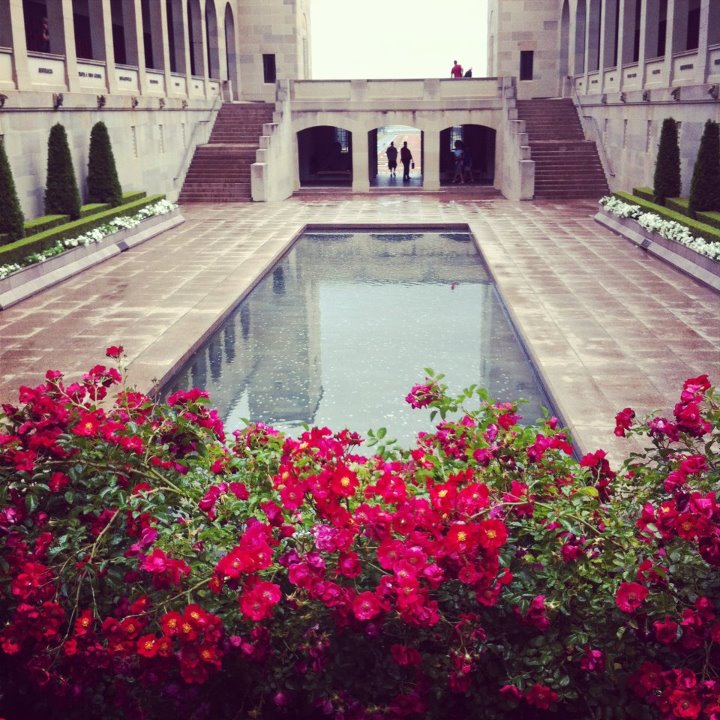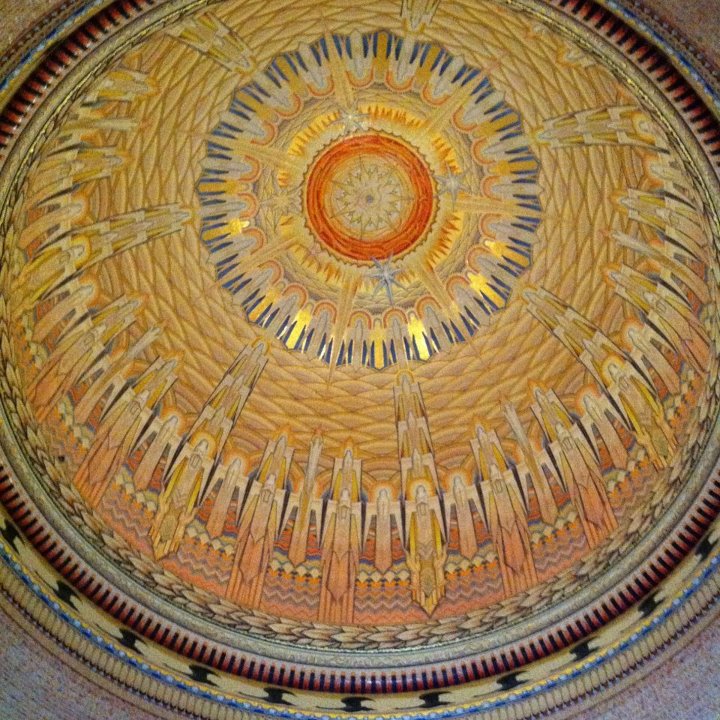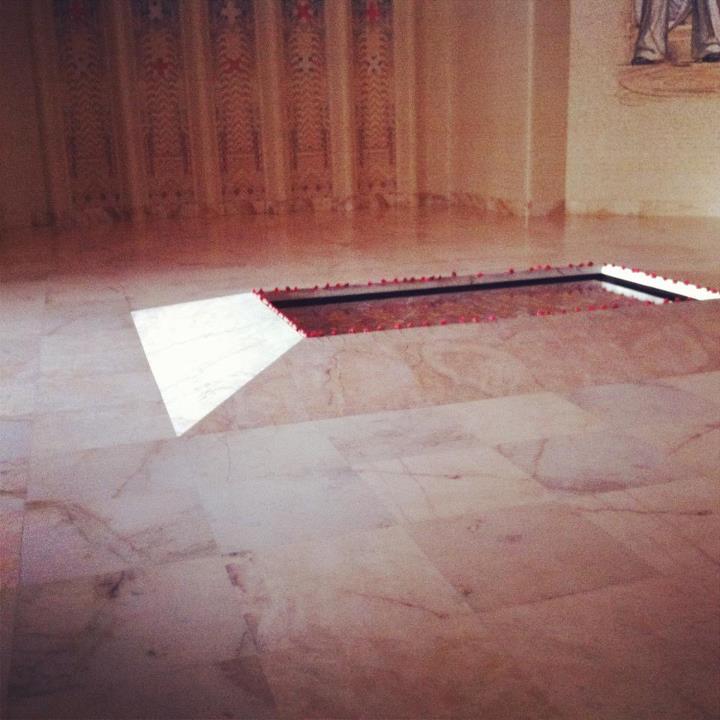Anzac and Awe: Religion, Violence, and the Media in Australia
By Zoe Alderton, University of Sydney
Published by the Religious Studies Project, on 9 May 2012 in response to the Religious Studies Project Interview with Jolyon Mitchell on Religion, Media and Violence (7 May 2012).
Jolyon Mitchell is Professor of Communications, Arts and Religion and Director of the Centre for Theology and Public Issues at the University of Edinburgh. In this latest podcast he discusses the relationship between religions and media, focusing on issues of violence and peace. This material touches on his upcoming book, Promoting Peace, Inciting Violence: The Role of Religion and Media (Routledge: 2012). In this text, Mitchell problematises overly-simplistic readings of the media’s role in discussions of religion, conflicts, and resolutions.
In this response to his podcast, I wish to summarise some of the fascinating points raised by Mitchell. In doing so, I aim to foreground those that may illuminate Australia and its approach to sacralised violence. Living in a country where the national culture is largely secular, it is interesting to consider what the implications for Mitchell’s research are on Australian media and its presentation/proliferation of violence. Mitchell mentions a variety of nations who have undergone relatively recent conflicts and conflict resolutions, which have somehow engaged with religious groups or belief systems. At first it may seem that Australia is totally outside of this paradigm. Since the genocide of our Indigenous population, we have not seen the same kind of civil war as Mozambique. Nor have we defended our borders in a manner comparable to the Iran-Iraq conflict. Religiously motivated terrorism is more of a fear than a reality. In terms of faith, Australia is nominally Christian but has no official state religion. While the importance of this religion in Australian culture should not be underplayed, it is not a tradition that is generally considered to be an agent of national bonding.
Nevertheless, Mitchell’s framing of the media and his comments on violence as a kind of public spectacle provide an effective lens through which to consider Australia’s complicated public engagement with Anzac Day and the Anzac legend. This national holiday, intrinsically connected to violence via its origin in a First World War conflict, has an arguably religious relationship with Australian nationhood. Through various media (including television broadcasts, paintings, movies, and sculptures) the very complex and ambivalent meaning of Anzac Day is negotiated and perpetuated. Mitchell’s arguments in regards to the sensationalism and spectacle of violence will be used to account for the extreme emphasis on sacred martyrdom that permeates our national legend via a pragmatic reading of its dissemination through popular media.
For those of you who wish to read a bit more about Anzac Day, the Anzac legend, and the relationship between Anzac Day and the Media, Zoe has written a longer version of this post which is accessible here.
The spectacle of violence
In Mitchell’s podcast, he describes occasions in which media become the site, source, and inspiration for different forms of violence. The broadcast of religious motifs is a clear part of this process. Mitchell uses the example of Iran during the Iran-Iraq War (1980-1988). In this conflict, posters and mural celebrating martyrdom were produced. These images did not just concern themselves with contemporary sacrifice in the immediate conflict. Rather they wove in foundational martyrdoms such as that of Imam Hussain Ibn Ali, often conveying both narratives at once. This relationship between the media and symbolic culture is a vitally important one. In modern Australia, the troops involved in current or more recent battles are constantly conflated with the original Anzacs, making their modern-day sacrifice part of an ongoing narrative of martyrdom that feels real and compelling in its immediacy.
On a related note, Mitchell claims that news media is drawn to spectacle, and that violence is spectacular. His suggestion that media attention is often unproductive in the peace-making process tends to imply that its utility is often in the realm of proliferating conflict. Thus, it is reasonable to view the news media as a channel that prioritises that which is exciting, colourful, or engaging. Spectacle connects an audience with their television or other news medium. Spectacle helps to proliferate the aforementioned immediacy of the Anzac martyrdom that is useful and desirable if Australia wishes to draw upon its citizens’ essentially positive attitude towards sacrifice in war. The televised aspects of Anzac Day and its associated rituals tend to focus on that which is engagingly monumental and celebratory. The solemn Dawn Service at Gallipoli, including the stirring ‘last post’ by a lone bugler, is necessary viewing for a substantial portion of the nation. It is part of their ritual, and is conveniently televised.
So too is the annual commemorative parade in which veterans of all Australian wars march (or are represented posthumously by their heirs). The televisation of the Anzac Day Parade helps the nation to participate in the imaginative renewal of its mythology. Slade (2003 p.792) calls the Gallipoli story part of the sustenance of Australia. Through television, all can participate in this ceremony of cultural renewal and recitation. Of course, violence need not be advocated by any of these moving, engaging, and spectacular ceremonies or their media portrayal. Indeed, there is little about them that is openly pugnacious. Instead, the media tends to valorise holy martyrdom, implying on occasion that such a sacrifice is still necessary in order to maintain the social order of Australia as we know it today.
Is Anzac Day an example of the ambivalent sacred?
A major part of Mitchell’s podcast is the complex interrelationship of war, peace, and religion. As connected as religions may be to violence, he maintains that they also have a role to play in pacificism. His podcast speaks comprehensively of “the ambivalence of the sacred,” a term coined by R. Scott Appleby. Mitchell employs this phrase to imply “the scared can both incite violence and promote peace.” He feels that religious agents are, and can be, part of the conflict resolution process. Interestingly, Mitchell argues that this role is less publicised as it tends to happen away from cameras. The arduous process of negotiating peace does not lend itself to short broadcasts. Perhaps the potentially peaceful or anti-violent aspects of the Anzac mythology have been ignored in the popular press due to a lack of interest or broadcastability. This does not mean that they are absent, or that the reverence inspired by the Gallipoli campaign and its commemorative sites could not inspire an entirely pacifistic agenda.
Indeed, it is not clear if the Anzac legend is a discourse of war or peace. It appears to be both simultaneously, but also has potential to represent only one side of the dichotomy depending on the cause that employs it. In his discussion of Anzac as sacred and secular simultaneously, Seal (2007 p.143) calls this myth the most powerful “manifestation of an ambivalence that lies at the heart of our sense of national identity.” He compares this tonal equivocality with the confusion over Ned Kelly as hero or villain, or the simultaneous perception of British citizens as our kin and rivals. So too can Australia be seen to negotiate the sombre spaces and ceremonies of Anzac veneration with the iconic larrikin soldier and his playful disrespect for pomposity. The Anzac mythology, in negotiating equivocal and contradictory meanings, opens itself up to possibilities for violence or peacemaking. It can be used as a call to arms for present-day conflicts or a means of expressing the horrors and suffering of war.
In the case of Anzac Day 2012, the news media has shown examples of ambivalence in terms celebrating or denying violence in the name of this mythology. This is exemplified in Charles Waterstreet’s Sydney Morning Herald article Civil War Defies the Anzac Spirit. Here Waterstreet rallies for suburban peace in the wake of violence in the Sydney region. He denounces the current climate in which criminals are fighting petty wars of bluff and false bravado, betraying those who died and tried to keep such conduct from our shores. Turf wars over drug-trafficking rights and injured pride are an embarrassment to this city, to the soldiers who fought in countless wars … Taking up arms in peacetime is to spit in the face of every soldier, sailor and airman who fought.
Ambivalence is certainly present in this division of ‘good violence’ and ‘bad violence’, framed within a discourse of respect for the Anzac tradition and the sacred sacrifice.
Celebrity and violence
Another applicable component of Mitchell’s podcast is the blurring of celebrity and religious leadership. This too may be read in to the impact of spectacle in regards to what is and is not broadcast. Mitchell argues that the popular media (for example, news broadcasters) thrive on the celebrity factor. Celebrities build audiences through a process of viewer identification. Media consumers feel as though they ‘know’ a celebrity or can identify with them. As this relationship is pre-existent, a news snippet need not feel obliged establish empathy or interest in such a figure. Considering the time poverty of televised news broadcasts, the employment of a familiar religious figure with a pre-established narrative and context makes pragmatic sense. Mitchell uses religious leaders such as the Dalai Lama as an example of a familiar face with a familiar agenda. In the case of Anzac ritual and mythology, political figures are the celebrities consulted by the media in this manner.
Of course, the political celebrities themselves are transient. Demerath and Williams (1985 p.160) specify that civil religions do not connect too closely with any specific government lest they become an “idolatrous cloak of transcendental rhetoric tossed over the pursuit of momentary ends.” The proposed ultimacy of the Anzac legend has remained supra-partisan despite its intimacy with the leadership of the day. Unsurprisingly, the figure of the Prime Minister seems to be the main focal point of this engagement. In 2012, Julia Gillard has upheld this mantle, not only in terms of her actual addresses to the nation, but also in regards to the sound bites of her speeches that were disseminated through the television and printed news. For example, in a particularly popular news article, Gillard referred to Anzac Day as all that Australia embodies, more significant in terms of emotions and values than Australia Day, and a meaningful event for migrants (like herself) “who freely embrace the whole of the Australian story as their own.” Putting aside disturbing political undertones, these convenient sound bites are easily broadcast around the nation, presented by a political celebrity who needs no introduction.
Although people with anti-Anzac or anti-war sentiments may have commented on the celebrations in an equally eloquent manner, they cannot compete with one of the most easily recognised faces of Australia in a media landscape that requires abbreviation. The political celebrity Barack Obama also made news (in a story that seems entirely overblown) after sending “best wishes” to Australia and New Zealand on Anzac Day. Although the sensationalist headline would suggest otherwise, Secretary of State Hillary Clinton delivered the message on Obama’s behalf. She also thanked Australia for their ongoing commitment to the war in Afghanistan, a meaningful conflation of past and present sacrifice of lives. Obama is another example of a celebrity who is suitable for a short news story on account of his national renown. His (albeit proxy) endorsement of the Anzac commemoration coupled with an endorsement of current conflicts requires little in the way of contextualisation.
Media and violence in its broadest sense
Mitchell’s broad take on the definition of ‘media’ is a useful one when considering the depth of a culture’s communicative devices. Although media is commonly shorthand for television and newspapers, Mitchell reminds us of the vast array of communicative devices that can fall under this umbrella term. Media need not be seen as the exclusive domain of the literary elect or wealthy broadcasters. Rather, Mitchell employs the term to describe a variety of devices from YouTube videos, to murals, to architecture. It is in the medium of architecture and effigy that Australia expresses some of its most reverential emotions towards the war dead.

The work of Ken Inglis, especially Sacred Places: War Memorials in the Australian Landscape (1998), is vital reading on this complex topic. To briefly summarise, Inglis illuminates war memorials as sacred shrines of Australian civil religion, allowing for the preservation of memory. This sacred architecture helps to reconcile the distance between Australia and Turkey. It is difficult to negotiate sacred turf when your creation narrative takes place in a foreign nation. Slade (2003 p.787) speaks of various features of the Gallipoli battleground that make it a sacred or elevated region. This includes the lack of modern development on the peninsula (keeping it ‘authentic’ to the era of the battle), the burial of the dead where they fell, and the subsequent framing of the entire area as a cemetery. Obviously, Australia itself cannot provide this kind of sacred Anzac space. Instead, war memorials are a way of making a geographically unconnected site equally meaningful.
In Canberra, Australia’s capital city, the Australian War Memorial contains the Hall of Memory, a cathedral-like structure that performs the typical duties of a religious shrine. Seal (2007 p.140) calls the Hall of Memory “spiritual but without religious symbolism.” Although it may not contain traditional religious indicators, it still evokes religious emotion. The Hall is designated as a place of eerie silence and hushed contemplation. It is clearly demarcated as a holy site that demands respect. It is also the tomb of the Unknown Solider, with his body housed like the relics of a saint. Above his remains, viewers may look upwards to a dome reminiscent of Byzantine cathedral architecture. The dome, created in brilliant gold hues, depicts souls migrating from distant battlefields. The Hall of Memory clearly connotes the existence of the extramundane.

The museum component of the Australian War Memorial should also be seen as a communicative device in terms of Australia’s relationship to sacred violence. As Chris Healy (1997 pp.73-74) argues, the museum is a medium that trains citizens in their acquisition of social memory. A visitor to the Australian War Memorial is encouraged to have a spiritual, or at least reflective, experience in the Hall of Memory. They may then use the educational, historical museum in order to arrange their feelings of awe, or reverence, or respect into a cultural narrative. This narrative, conveyed through the museum medium, contextualises the violence and horrific loss of the nation into a rhetoric of sacrifice, sacred ‘mateship’, and a patriotism that transcends personal concerns.

Conclusions
Much more could be said on the Anzac legend, its various components, and the reverential lack of critique it receives in the present era. I believe it is valuable to consider what our state mythology and most revered holiday dictates in terms of the national character. Mitchell’s exploration of the sensationalism and spectacle of violence explains much in terms of the news media’s preferences as to which aspects of the legend they choose to show and propagate. So too does Mitchell help to illuminate the value of celebrity in moral debates. Pragmatically speaking, the Anzac narrative is a story that most Australians know and care about. It is a discourse that is easily associated with well-known political and public figures. It is also an exciting and visually stimulating event that transfers well to the broadcasting of its rituals, or the artistic enactment of its sacred narratives and archetypal heroes. At its core, the Anzac mythology may indeed contain the ambivalence that Mitchell sees in the relationship between religion, violence, and peace. Nevertheless, its present incarnation seems to be concerned with the public condoning of martyrdom and the celebration of militaristic duty in deeply spiritualised terms.
This material is disseminated under a Creative Commons Attribution-NonCommercial-NoDerivs 3.0 Unported License. and can be distributed and utilised freely, provided full citation is given.
About the Author:
 Zoe Alderton is a PhD candidate in the department of Studies in Religion at the University of Sydney. Her thesis concerns the New Zealand artist Colin McCahon and the nature of his audience reception. Zoe’s main interests are religion in modern art and religious communication via new media. Her recent publications include a discussion of the inheritance of Theosophy in Australian modernism, and an exploration of the contentious politics surrounding the Blake Prize for Religious Art. Upcoming publications concern imaginative pilgrimage in the work of Colin McCahon, and a discussion of the motifs in his beachside theology. Zoe is also a tutor in Sociology for the University of Western Sydney and reviews editor for the journal Literature & Aesthetics.
Zoe Alderton is a PhD candidate in the department of Studies in Religion at the University of Sydney. Her thesis concerns the New Zealand artist Colin McCahon and the nature of his audience reception. Zoe’s main interests are religion in modern art and religious communication via new media. Her recent publications include a discussion of the inheritance of Theosophy in Australian modernism, and an exploration of the contentious politics surrounding the Blake Prize for Religious Art. Upcoming publications concern imaginative pilgrimage in the work of Colin McCahon, and a discussion of the motifs in his beachside theology. Zoe is also a tutor in Sociology for the University of Western Sydney and reviews editor for the journal Literature & Aesthetics.
References:
Bellah, R.N., 1967. ‘Civil Religion in America’, Daedalus, vol. 96, no. 1, pp. 1-21.
Crouter, R., 1990. ‘Beyond Bellah: American Civil Religion and the Australian Experience’, Australian Journal of Politics and History, vol. 36, no. 2, pp. 154-165.
Demerath, N.J., and Williams, R.H., 1985. ‘Civil Religion in an Uncivil Society’, Annals of the American Academy of Political and Social Science, vol. 480, pp. 154-166.
Geertz, C., 1966. ‘Religion as a Cultural System’, in M. Banton (ed.), Anthropological Approaches to the Study of Religion, Tavistock, London.
Healy, C., 1997. From the Ruins of Colonialism: History As Social Memory, Cambridge University Press, United Kingdom.
Inglis, K., 1998. Sacred Places: War Memorials in the Australian Landscape, Melbourne University Press, Melbourne.
Sacket, L. 1985. ‘Marching Into the Past: Anzac Day Celebrations in Adelaide’, Journal of Australian Studies, vol. 9, iss. 17, pp. 18-30.
Seal, G., 2007. ‘ANZAC: The Sacred in the Secular’, Journal of Australian Studies, vol. 31, iss. 91, pp. 135-144.
Slade, P., 2003. ‘Gallipoli Thanatourism: The Meaning of ANZAC’, Annals of Tourism Research, vol. 30, no. 4, pp.779-794.



